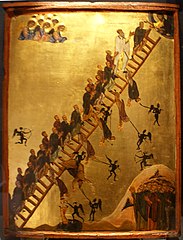The Orthodox church maintains a web-page for the monastery where the codex was found:
The Holy Monastery of the God-trodden Mount Sinai, Saint Catherine’s Monastery
That church claims that this is the precise spot where god God spoke to Moses in the fable known as the 'burning-bush' incident. Hence the term 'god-trodden,'

The monastery was built at the command of Emperor Justinian I (527-565 CE) an early Christian Emperor. Some claim it to be the oldest monastery still in use.
Reference: https://en.wikipedia.org/wiki/Saint_Catherine%27s_Monastery
For the curious, there are many things of interest if you have the wherewithal to make this visit. There are other biblical manuscripts and religious icons ...

including this one, known as 'The 12th century Ladder of Divine Ascent " showing monks, led by John Climacus, ascending the ladder to Jesus, at the top right.
Seems to me that it was a type of my life as a Christian. you can see me (the antitype) falling off as I neared Jesus in the top right of the ladder.
Another interesting document is the
Quote" The Achtiname of Muhammad, also known as the Covenant or (Holy) Testament (Testamentum) of the Prophet Muhammad, is a document or ahdname which is a charter or writ ratified by the Islamic Prophet Muhammad granting protection and other privileges to the Christian monks of Saint Catherine's Monastery. It is sealed with an imprint representing Muhammad's hand."

A tradition is maintained that (quote)
" Muhammad frequented the monastery and had great relationships and discussions with the Sinai fathers.[3] The document claims that the Prophet (570–632) had personally granted by charter in the second year of the Hegira, corresponding to AD 626, the rights and privileges to all Christians "far and near". It consists of several clauses on such topics as the protection of Christians living under Islamic rule as well as pilgrims on their way to monasteries, freedom of worship and movement, freedom to appoint their own judges and to own and maintain their property, exemption from military service and taxes, and the right to protection in war." Reference: https://en.wikipedia.org/wiki/Ashtiname_of_Muhammad


